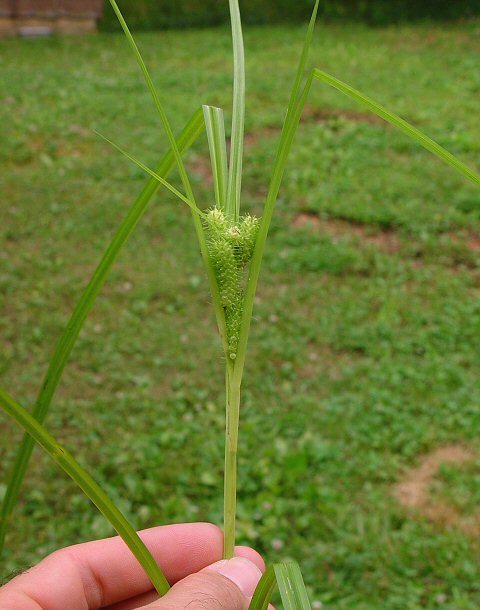Carex frankii Kunth
Frank's Sedge

Native
CC = 2
CW = 0
MOC = 84
© DETenaglia
Carex frankii KunthFrank's Sedge | |
 |
Native CC = 2 CW = 0 MOC = 84 |
© DETenaglia |
|
Family - Cyperaceae Habit - Monoecious sedge with short rhizomes, forming clumps. Stems - Flowering stems 15-80 cm long, bluntly trigonous, tinged reddish purple at the base.
Leaves - Leaf blades 2-60 cm long, 3-10 mm wide, flat. Leaf sheaths with the tip not extended past the insertion point of the leaf, truncate to shallowly concave, the ligule shorter than to longer than wide and U-or V-shaped, the ventral side tinged yellowish brown, the lowermost sheaths tinged reddish purple.
Inflorescence - Inflorescence with 3-8 spikes mostly densely spaced near the tip of the axis, the lowermost bract with a well-developed sheath.
Spikes - Terminal spike usually entirely staminate (rarely with a few perigynia at the tip), 5-40 mm long, the staminate scales 5-8 mm long, linear, the tip tapered gradually to an awn, green with white margins. Lateral spikes 2-7, 10-50 mm long, 8-12 mm wide, narrowly oblong in outline, rounded at both ends, the pistillate scales 5-12 mm long, linear, the tip tapered gradually to a long awn, equaling or surpassing the perigynium, green with white margins.
Perigynia - Perigynia 3.5-6.0 mm long, spreading widely to horizontal, inflated, circular to bluntly trigonous in cross-section, the main body obovate to obtriangular in outline, widest above the middle, truncate or abruptly narrowed to a slender, stiff beak with a pair of sharply pointed, stiff teeth at the tip, narrowed to the base, the surface with 2 ribs and 10-18 fine nerves, yellowish green to olive green at maturity. Styles straight or nearly so. Fruits with the main body 1.5-2.3 mm long, obovate in outline, bluntly trigonous, brownish yellow, often somewhat shiny.
Flowering - May - September. Habitat - Bottomland forests, bottomland prairies, wet meadows, streambanks, pond margins, sloughs, fens, railroads, roadsides, ditches, moist margins of crop fields. Origin - Native to the U.S. Lookalikes - Other sedges, particularly C. lurida. Other info. - This species can be found throughout nearly all of Missouri except for the far northwestern corner. It is also found throughout the southeastern quadrant of the continental U.S. The plant can be identified by its long bracts which subtend the inflorescence, its dense, spreading, beaked perigynia (which are broadest in the apical 1/2), its rough-awned pistillate scales, and its moist habitat. The perigynia taper abruptly to the prominent beak. Photographs taken in the Ozark Scenic Riverways, Shannon County, MO., 6-26-03 (DETenaglia); also at Pacific Palisades Conservation Area, MO, 7-26-2020 (SRTurner). |